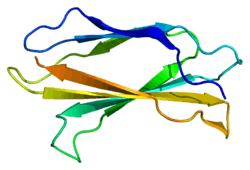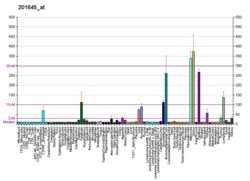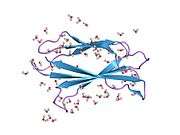Tenascin C
Tenascin C (TN-C) is a glycoprotein that in humans is encoded by the TNC gene.[5][6] It is expressed in the extracellular matrix of various tissues during development, disease or injury, and in restricted neurogenic areas of the central nervous system.[7][8] Tenascin-C is the founding member of the tenascin protein family. In the embryo it is made by migrating cells like the neural crest; it is also abundant in developing tendons, bone and cartilage.
Gene and expression
The human tenascin C gene, TN-C, is located on chromosome 9 with location of the cytogenic band at the 9q33. The entire Tenascin family coding region spans approximately 80 kilobases translating into 2203 amino acids.[9]
Expression of TN-C changes from development to adulthood. TN-C is highly expressed during embryogenesis and is briefly expressed during organogenesis, while in developed organs, expression is absent or in trace amounts.[10] TN-C has been shown to be upregulated under pathological conditions caused by inflammation, infection, tumorigenesis, and at sites that are subject to unique biomechanics forces.[10][11]
The regulation of TN-C is induced or repressed by a number of different factors that are expressed during embryonic tissue, as well as developed tissues during remodeling, injured, or neoplastic.[12] TGF-β1, tumor necrosis factor-α, interleukin-1, nerve growth factor, and keratinocyte growth factor are factors that have been shown to regulate TN-C.[13] Other extracellular matrix components such as matrix metalloproteins and integrins are also frequently co-expressed with TN-C.[14]
In the developing central nervous system, TN-C is involved in regulating the proliferation of both oligodendrocyte precursor cells and astrocytes. Expression of TN-C by radial glia precedes the onset of gliogenesis, during which time it is thought to drive the differentiation of astrocytes.[8] In the adult brain, TN-C expression is downregulated except for the areas that maintain neurogenesis into adulthood and the hypothalamus.[8] TN-C is also present in central nervous system injuries and gliomas.[8]
Structure
Tenascin C is an oligomeric glycoprotein composed of individual polypeptides with molecular weights ranging from 180 to ~300kDa. The Tenascin family of proteins shares a similar structural pattern. These similar modules include heptad repeats, EGF-like repeats, fibronectin type III domains, and a C-terminal globular domain shared with fibrinogens. These protein modules are lined up like beads on a string and give rise to long and extended molecules.[9] At the N-terminus each Tenascin has an oligomerization domain which in the case of TN-C leads to the formation of hexamers.[9] TN-C and -R are known to be subject to alternative splicing. In human TN-C there exists, in addition to the eight constant repeats, nine extra repeats subject to alternative splicing. This results in a multitude of TN-C subunits differing in the number and identity of fibronectin type III domain repeats.[10]
Interactions
Tenascin-C has been shown to interact with fibronectin.[15] This interaction is shown to have the potential to modify cell adhesion.[16] A solid-state interaction between fibronectin and TN-C results in cellular upregulation of matrix metalloproteinase expression.[17]
TN-C also interacts with one or more TN-C receptors on cells which activate and repress the same signal transduction pathway. An example of this interaction is the adhesion of SW80 carcinoma cells to the third FN-III repeat of TN-C via the αvβ3 integrin receptor leads to cell spreading, phosphorylation of focal adhesion kinase, paxillin and ERK2 MAPK, and proliferation.[18] In contrast, when these same cells use either α9β1 or αvβ6 integrins to adhere to the same third FN type III repeat, cell spreading is attenuated and activation of these signaling mediators and cell growth is suppressed or fails to occur.
Function
Tenascin C is a very diverse protein that can produce different functions within the same cell type. This myriad of functions is accomplished through alternative splicing of mRNA as well as the temporal activation of signal transduction pathways and/or target genes at different stages of growth or differentiation.[12] TN-C is classified as an adhesion-modulating protein, because it has been found to inhibit cellular adhesion to fibronectin.[10]
Much of the functional studies are inferred from various TN-C knockout mice models. TN-C clearly plays a role in cell signaling as evidenced by its ability to be induced during events such as trauma, inflammation, or cancer development. Also, TN-C is important in regulating cell proliferation and migration, especially during developmental differentiation and wound healing.[19]
Clinical significance
Tenascin C continues to be researched as a potential biomarker for a number of diseases such as myocarditis[20] and different forms of cancer. The numerous involvements with cellular functioning and signaling make TN-C a popular protein to study in developing new therapies and detection methods. Recent work has shown that TN-C inhibits HIV infection in immune cells by binding to a chemokine coreceptor site on the HIV-1 envelope protein, blocking the virus' entry into the host cells.[21][22]
Role in cancer
Tenascin C is implicated in a number of different cancers such as osteosarcomas,[23] chondrosarcomas,[24] bladder cancer,[25] and glioblastomas.[26] In glioblastoma cells, Tenascin-C expression provides much clinical and functional significance in terms of cancer prognosis and tumor progression. The endogenous pool of tenascin-C isoforms in gliomas supports both tumor cell proliferation and migration.[26] Because tenascin-C is essential to the survival of these various forms of cancers, tenascin-c expression could be a potential biomarker for cancer detection. Also, tenascin-C antibodies have been used to diagnose and create therapies for many different types of cancers.[27][28]
See also
References
- GRCh38: Ensembl release 89: ENSG00000041982 - Ensembl, May 2017
- GRCm38: Ensembl release 89: ENSMUSG00000028364 - Ensembl, May 2017
- "Human PubMed Reference:". National Center for Biotechnology Information, U.S. National Library of Medicine.
- "Mouse PubMed Reference:". National Center for Biotechnology Information, U.S. National Library of Medicine.
- Nies DE, Hemesath TJ, Kim JH, Gulcher JR, Stefansson K (March 1991). "The complete cDNA sequence of human hexabrachion (Tenascin). A multidomain protein containing unique epidermal growth factor repeats". J Biol Chem. 266 (5): 2818–23. PMID 1704365.
- Siri A, Carnemolla B, Saginati M, Leprini A, Casari G, Baralle F, Zardi L (May 1991). "Human tenascin: primary structure, pre-mRNA splicing patterns and localization of the epitopes recognized by two monoclonal antibodies". Nucleic Acids Res. 19 (3): 525–31. doi:10.1093/nar/19.3.525. PMC 333643. PMID 1707164.
- Midwood, Kim S.; Hussenet, Thomas; Langlois, Benoit; Orend, Gertraud (5 August 2011). "Advances in tenascin-C biology". Cellular and Molecular Life Sciences. 68 (19): 3175–3199. doi:10.1007/s00018-011-0783-6. PMC 3173650. PMID 21818551.
- Wiese S, Karus M, Faissner A (2012). "Astrocytes as a source for extracellular matrix molecules and cytokines". Front Pharmacol. 3: 120. doi:10.3389/fphar.2012.00120. PMC 3382726. PMID 22740833.
- Gulcher JR, Nies DE, Alexakos MJ, Ravikant NA, Sturgill ME, Marton LS, Stefansson K (1991). "Structure of the human hexabrachion (tenascin) gene". Proc. Natl. Acad. Sci. U.S.A. 88 (21): 9438–42. doi:10.1073/pnas.88.21.9438. PMC 52733. PMID 1719530.
- Chiquet-Ehrismann R (June 2004). "Tenascins". Int. J. Biochem. Cell Biol. 36 (6): 986–90. doi:10.1016/j.biocel.2003.12.002. PMID 15094113.
- Webb CM, Zaman G, Mosley JR, Tucker RP, Lanyon LE, Mackie EJ (1997). "Expression of tenascin-C in bones responding to mechanical load". J. Bone Miner. Res. 12 (1): 52–8. doi:10.1359/jbmr.1997.12.1.52. PMID 9240725.
- Jones PL, Jones FS (2000). "Tenascin-C in development and disease: gene regulation and cell function". Matrix Biol. 19 (7): 581–96. doi:10.1016/s0945-053x(00)00106-2. PMID 11102748.
- Rettig WJ, Triche TJ, Garin-Chesa P (1989). "Stimulation of human neuronectin secretion by brain-derived growth factors". Brain Res. 487 (1): 171–7. doi:10.1016/0006-8993(89)90954-2. PMID 2752284.
- Akhurst RJ, Lehnert SA, Faissner A, Duffie E (1990). "TGF beta in murine morphogenetic processes: the early embryo and cardiogenesis". Development. 108 (4): 645–56. PMID 1696875.
- Chung CY, Zardi L, Erickson HP (1995). "Binding of tenascin-C to soluble fibronectin and matrix fibrils". J. Biol. Chem. 270 (48): 29012–7. doi:10.1074/jbc.270.48.29012. PMID 7499434.
- Jones PL, Crack J, Rabinovitch M (1997). "Regulation of Tenascin-C, a Vascular Smooth Muscle Cell Survival Factor That Interacts with the Αvβ3 Integrin to Promote Epidermal Growth Factor Receptor Phosphorylation and Growth". J. Cell Biol. 139 (1): 279–93. doi:10.1083/jcb.139.1.279. PMC 2139818. PMID 9314546.
- Tremble P, Chiquet-Ehrismann R, Werb Z (1994). "The extracellular matrix ligands fibronectin and tenascin collaborate in regulating collagenase gene expression in fibroblasts". Mol. Biol. Cell. 5 (4): 439–53. doi:10.1091/mbc.5.4.439. PMC 301053. PMID 7519905.
- Yokosaki Y, Monis H, Chen J, Sheppard D (1996). "Differential effects of the integrins alpha9beta1, alphavbeta3, and alphavbeta6 on cell proliferative responses to tenascin. Roles of the beta subunit extracellular and cytoplasmic domains". J. Biol. Chem. 271 (39): 24144–50. doi:10.1074/jbc.271.39.24144. PMID 8798654.
- Erickson HP (199). "Tenascin-C, tenascin-R and tenascin-X: a family of talented proteins in search of functions". Curr. Opin. Cell Biol. 5 (5): 869–76. doi:10.1016/0955-0674(93)90037-q. PMID 7694605.
- Imanaka-Yoshida K, Hiroe M, Yasutomi Y, Toyozaki T, Tsuchiya T, Noda N, Maki T, Nishikawa T, Sakakura T, Yoshida T (2002). "Tenascin-C is a useful marker for disease activity in myocarditis". J. Pathol. 197 (3): 388–94. doi:10.1002/path.1131. PMID 12115886.
- Fouda GG, Jaeger FH, Amos JD, Ho C, Kunz EL, Anasti K, Stamper LW, Liebl BE, Barbas KH, Ohashi T, Moseley MA, Liao HX, Erickson HP, Alam SM, Permar SR (2013). "Tenascin-C is an innate broad-spectrum, HIV-1-neutralizing protein in breast milk". Proc. Natl. Acad. Sci. U.S.A. 110 (45): 18220–5. doi:10.1073/pnas.1307336110. PMC 3831436. PMID 24145401.
- Mangan RJ, Stamper L, Ohashi T, Eudailey JA, Go EP, Jaeger FH, Itell HL, Watts BE, Fouda GG, Erickson HP, Alam SM, Desaire H, Permar SR (2019). "Determinants of Tenascin-C and HIV-1 envelope binding and neutralization". Mucosal Immunology. 12 (4): 1004–12. doi:10.1038/s41385-019-0164-2. PMC 6599478. PMID 30976088.
- Tanaka M, Yamazaki T, Araki N, Yoshikawa H, Yoshida T, Sakakura T, Uchida A (2000). "Clinical significance of tenascin-C expression in osteosarcoma: tenascin-C promotes distant metastases of osteosarcoma". Int. J. Mol. Med. 5 (5): 505–10. doi:10.3892/ijmm.5.5.505. PMID 10762653.
- Ghert MA, Jung ST, Qi W, Harrelson JM, Erickson HP, Block JA, Scully SP (2001). "The clinical significance of tenascin-C splice variant expression in chondrosarcoma". Oncology. 61 (4): 306–14. doi:10.1159/000055338. PMID 11721178.
- Brunner A, Mayerl C, Tzankov A, Verdorfer I, Tschörner I, Rogatsch H, Mikuz G (2004). "Prognostic significance of tenascin-C expression in superficial and invasive bladder cancer". J. Clin. Pathol. 57 (9): 927–31. doi:10.1136/jcp.2004.016576. PMC 1770417. PMID 15333651.
- Herold-Mende C, Mueller MM, Bonsanto MM, Schmitt HP, Kunze S, Steiner HH (March 2002). "Clinical impact and functional aspects of tenascin-C expression during glioma progression". Int. J. Cancer. 98 (3): 362–9. doi:10.1002/ijc.10233. PMID 11920587.
- Daniels DA, Chen H, Hicke BJ, Swiderek KM, Gold L (2003). "A tenascin-C aptamer identified by tumor cell SELEX: systematic evolution of ligands by exponential enrichment". Proc. Natl. Acad. Sci. U.S.A. 100 (26): 15416–21. doi:10.1073/pnas.2136683100. PMC 307582. PMID 14676325.
- Orend G, Chiquet-Ehrismann R (2006). "Tenascin-C induced signaling in cancer". Cancer Lett. 244 (2): 143–63. doi:10.1016/j.canlet.2006.02.017. PMID 16632194.
Further reading
- Imanaka-Yoshida K, Hiroe M, Yoshida T (2004). "Interaction between cell and extracellular matrix in heart disease: multiple roles of tenascin-C in tissue remodeling". Histol. Histopathol. 19 (2): 517–25. PMID 15024713.
- Leahy DJ, Hendrickson WA, Aukhil I, Erickson HP (1992). "Structure of a fibronectin type III domain from tenascin phased by MAD analysis of the selenomethionyl protein". Science. 258 (5084): 987–91. doi:10.1126/science.1279805. PMID 1279805.
- White DM, Mikol DD, Espinosa R, et al. (1992). "Structure and chromosomal localization of the human gene for a brain form of prostaglandin D2 synthase". J. Biol. Chem. 267 (32): 23202–8. PMID 1385416.
- Gulcher JR, Nies DE, Marton LS, Stefansson K (1989). "An alternatively spliced region of the human hexabrachion contains a repeat of potential N-glycosylation sites". Proc. Natl. Acad. Sci. U.S.A. 86 (5): 1588–92. doi:10.1073/pnas.86.5.1588. PMC 286743. PMID 2466295.
- Yokosaki Y, Palmer EL, Prieto AL, et al. (1994). "The integrin alpha 9 beta 1 mediates cell attachment to a non-RGD site in the third fibronectin type III repeat of tenascin". J. Biol. Chem. 269 (43): 26691–6. PMID 7523411.
- Glumoff V, Savontaus M, Vehanen J, Vuorio E (1994). "Analysis of aggrecan and tenascin gene expression in mouse skeletal tissues by northern and in situ hybridization using species specific cDNA probes". Biochim. Biophys. Acta. 1219 (3): 613–22. doi:10.1016/0167-4781(94)90220-8. PMID 7524681.
- Gherzi R, Carnemolla B, Siri A, et al. (1995). "Human tenascin gene. Structure of the 5'-region, identification, and characterization of the transcription regulatory sequences". J. Biol. Chem. 270 (7): 3429–34. doi:10.1074/jbc.270.7.3429. PMID 7531707.
- Weinacker A, Ferrando R, Elliott M, et al. (1995). "Distribution of integrins alpha v beta 6 and alpha 9 beta 1 and their known ligands, fibronectin and tenascin, in human airways". Am. J. Respir. Cell Mol. Biol. 12 (5): 547–56. doi:10.1165/ajrcmb.12.5.7537970. PMID 7537970.
- Schnapp LM, Hatch N, Ramos DM, et al. (1995). "The human integrin alpha 8 beta 1 functions as a receptor for tenascin, fibronectin, and vitronectin". J. Biol. Chem. 270 (39): 23196–202. doi:10.1074/jbc.270.39.23196. PMID 7559467.
- Sriramarao P, Mendler M, Bourdon MA (1993). "Endothelial cell attachment and spreading on human tenascin is mediated by alpha 2 beta 1 and alpha v beta 3 integrins". J. Cell Sci. 105 (4): 1001–12. PMID 7693733.
- Prieto AL, Edelman GM, Crossin KL (1993). "Multiple integrins mediate cell attachment to cytotactin/tenascin". Proc. Natl. Acad. Sci. U.S.A. 90 (21): 10154–8. doi:10.1073/pnas.90.21.10154. PMC 47732. PMID 7694284.
- Zagzag D, Friedlander DR, Dosik J, et al. (1996). "Tenascin-C expression by angiogenic vessels in human astrocytomas and by human brain endothelial cells in vitro". Cancer Res. 56 (1): 182–9. PMID 8548761.
- Burg MA, Tillet E, Timpl R, Stallcup WB (1996). "Binding of the NG2 proteoglycan to type VI collagen and other extracellular matrix molecules". J. Biol. Chem. 271 (42): 26110–6. doi:10.1074/jbc.271.42.26110. PMID 8824254.
- Rauch U, Clement A, Retzler C, et al. (1997). "Mapping of a defined neurocan binding site to distinct domains of tenascin-C". J. Biol. Chem. 272 (43): 26905–12. doi:10.1074/jbc.272.43.26905. PMID 9341124.






